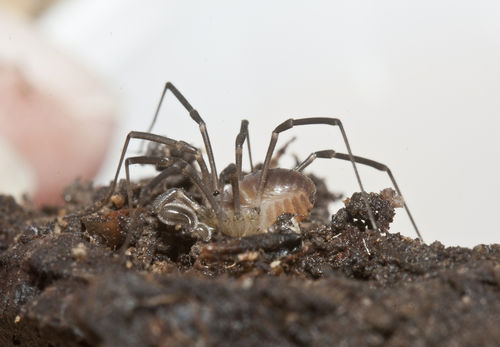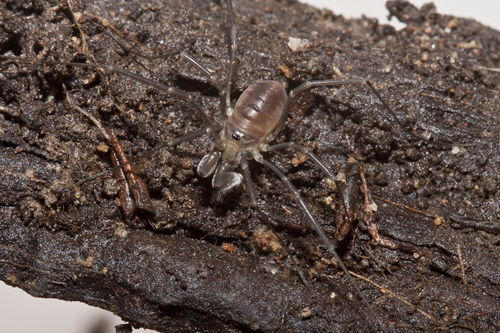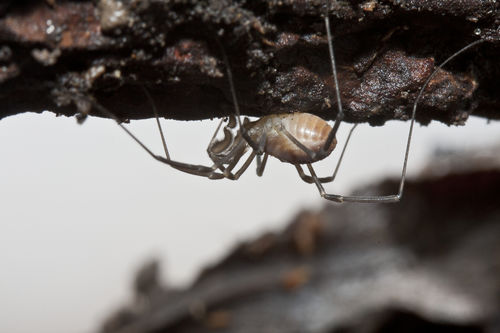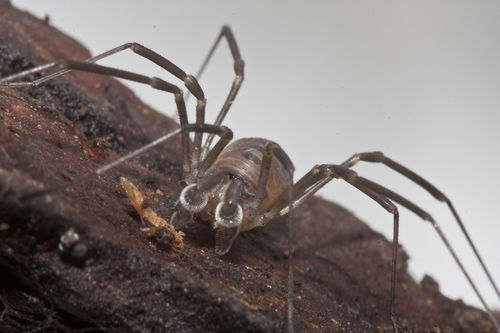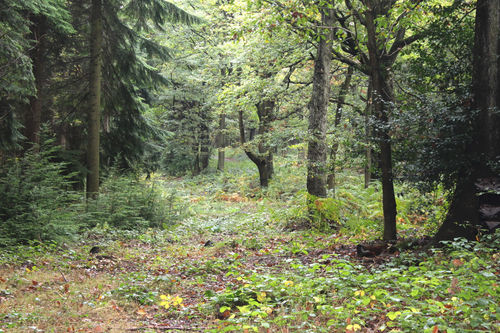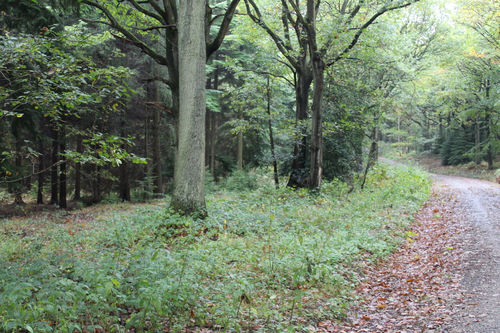A new Harvestman in the Wyre Forest. Sabacon viscayanum subsp. ramblaianum Martens, 1983
Rosemary Winnall with Nicki Farmer
On 12th October 2013 the Wyre Forest Study Group, in conjunction with the Conchological Society of Great Britain and Ireland, ran a field meeting at Hawkbatch, one of Wyre’s Forestry Commission woodlands. Although this ancient, semi-natural woodland is located in modern Worcestershire just north of Bewdley, the vice county is actually VC 39 Staffordshire.
The event was titled Slugs and Land Caddis and we aimed to increase our knowledge of the distribution within Wyre of the Lemon Slug Malacolimax tenellus and the Land Caddis Enoicyla pusilla, the male of the latter is on the wing at this time of the year. 15 participants attended and we had experts with us in mycology, hymenoptera, diptera, coleoptera and orthoptera as well as molluscs, so we were recording fungi and several different groups of invertebrates as we moved slowly through the trees in this mixed woodland.
I started identifying and recording harvestmen about three years ago and one of our participants - Nicki Farmer - kindly brought me specimens during our walk. Some I could identify with a hand lens and others I collected for a closer look under the microscope. As soon as I saw this individual, I knew it was a special find, but did not realise at the time just how restricted its distribution was. Its body was about 4mm long, but it was the large and unusual pedipalps that were immediately conspicuous. They were longer than the body, swollen, and covered in many spines and hairs. They give the harvestman a rather front-heavy appearance and make the identification unmistakable (01, 02, 03 & 04).
The habitat in which this female Sabacon viscayanum subsp. ramblaianum was discovered at grid reference SO765776, is a narrow belt of oak/birch/holly trees along the side of a forestry track on the edge of a conifer plantation of mature Western Hemlock Tsuga heterophylla and Douglas Fir Pseudotsuga menziesii (05 & 06). Conifer had been removed from this 20m strip during the winter of 2011/12. As a result there are areas of open ground, mossy conifer stumps and leaf litter. Some plants of disturbed soil such as Foxglove Digitalis purpurea, Common Hemp Nettle Galeopsis tetrahit and Wood Avens Geum urbanum have seeded in, and Western Hemlock saplings proliferate in some places. Soft Rush Juncus effusus indicates the presence of a few damp areas along the extraction route, and on less disturbed ground there are occasional patches of Bilberry Vaccinum myrtillus, Wood Melick Melica uniflora and Creeping Soft Grass Holcus mollis, with Bramble Rubus fruticosus agg. and Bracken Pteridium aquilinum growing alongside the forest track.
When Nicki found this harvestman it was on some low-growing vegetation, although we could not relocate the exact spot to collect more precise details. Whether we had disturbed it from the leaf litter as we walked through or not, we do not know.
This species was first found in Great Britain in September 1980 in woodland at Parkmill, Gower, Glamorgan (Abbot 1981). By 1999 it had been found from 22 sites in South Wales, including one near Presteigne that is actually just across the border into England (Hillyard 1999). So the Wyre Forest record is not the first English record! There is some discussion about whether this species is native to the UK or an introduction. Although some of the sites are close to industrial workings, it has also been found in old damp woodland, which is its usual habitat elsewhere in its range.
I remember there was some felling work in Hawkbatch a few years ago when the Forestry Commission’s warning signs were in both Welsh and English, which provided some comment from the locals at the time. With the movements of forestry vehicles and contractors, could this little harvestman have been introduced in the soil on a forest vehicle? Or has it been here all the time? We must look at more sites across the Wyre Forest and see if we can find it in more remote locations!
References:
Abbot, R.H.R. 1981. A new opilionid to Great Britain. Newsletter British Arachnological Society 30:4.
Hillyard, P.D. 2005. Harvestmen. Synopses of the British Fauna No. 4. (Third Edition). Field Studies Council, Preston Montford.
Morgan, I.K. 1990. Notes on the Ecology and British Status of the Opilionid Sabacon viscayanum subsp. Ramblaianum. Dyfed Invertebrate Group Newsletter 19: 15-18
Ocularium, Newsletter of the Opiliones Recording Scheme No 2 November 1999. Ed. Paul Hillyard
Images
01. Sabacon viscayanum ramblaianum Wyre Forest. Rosemary Winnall.
02. Sabacon viscayanum ramblaianum Wyre Forest. Rosemary Winnall
03. Sabacon viscayanum ramblaianum Wyre Forest. Rosemary Winnall
04. Sabacon viscayanum ramblaianum Wyre Forest. Rosemary Winnall
05. The habitat of Sabacon viscayanum in Wyre Forest. Rosemary Winnall
06. The habitat of Sabacon viscayanum in Wyre Forest. Rosemary Winnall
